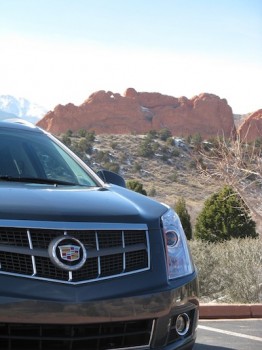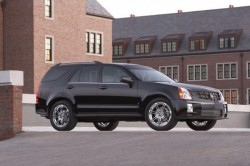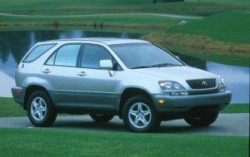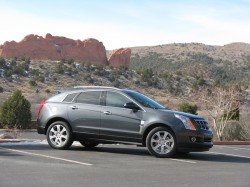2010 SRX turbo - Overview
Part 1 - OverviewPart 2 - Our test carPart 3 - Exterior and DesignPart 4 - Interior and ElectronicsPart 5 - Ride and Performance
Image galleries - SRX Review Pics | SRX Pics from Cadillac
What we are looking at here is the automotive equivalent of a Hollywood franchise 'reboot' - where the name and basic story stay the same, but all the actors, director, etc. are replaced to take things in a different direction.. In terms of risk, the shift Cadillac took with the SRX for its second generation would be like the Harry Potter movies dropping Daniel Radcliffe for one of the Jonas brothers. Sure it might look to the execs like you would get benefits such as pulling in a different demographic - but the previous fans might just come after you with torches and pitchforks for screwing with 'their baby'.
So, what has Cadillac done, why did they do it, and will they need to raise the drawbridges to keep out the angry hordes?
 The original SRX debuted in 2004 as the second vehicle in the Cadillac Art & Science renaissance (following the original CTS). Both were inspired by the Evoq concept (itself becoming the Corvette-based XLR also in 2004). The SRX shared its premium rear-drive Sigma chassis architecture with the CTS though it carried the CTS' top 3.6l V-6 as its base powerplant and had an optional 4.6l Northstar V-8 as wel. The SRX also shared the original CTS' dash design for the first few years before getting the first of Cadillac's 'Cut-and-Sew' interior treatments in 2007. The SRX looked, for all intents and purposes, as though it were a tall wagon version of the CTS.
Cadillac positioned this 3-row vehicle as their entry-level SUV, living below the Escalade. Unfortunately, an SUV isn't exactly how consumers viewed it.
Car shoppers looking for space and all-wheel drive viewed the SRX as a bit too much like an SUV and SUV shoppers saw the SRX as a bit too much like a wagon. This 'neither fish nor fowl' design didn't stop the SRX from receiving critical acclaim from the motoring press, with heavyweights such as Car and Driver awarding it first place in a comparison test against other luxury SUVs in its debut year, a spot in the 5Best trucks list 3 years in a row, and second place in a later SUV comparison test in 2007 (then losing only to the Acura MDX). Despite the accolades, the SRX was never a brisk seller and in its run from 2004-2009 sold far fewer than its competition.
And what might that competition be?
For that, let's look at the luxury utility market and see who is setting the pace and drawing the most sales at this price point...Lexus and their RX.
The original SRX debuted in 2004 as the second vehicle in the Cadillac Art & Science renaissance (following the original CTS). Both were inspired by the Evoq concept (itself becoming the Corvette-based XLR also in 2004). The SRX shared its premium rear-drive Sigma chassis architecture with the CTS though it carried the CTS' top 3.6l V-6 as its base powerplant and had an optional 4.6l Northstar V-8 as wel. The SRX also shared the original CTS' dash design for the first few years before getting the first of Cadillac's 'Cut-and-Sew' interior treatments in 2007. The SRX looked, for all intents and purposes, as though it were a tall wagon version of the CTS.
Cadillac positioned this 3-row vehicle as their entry-level SUV, living below the Escalade. Unfortunately, an SUV isn't exactly how consumers viewed it.
Car shoppers looking for space and all-wheel drive viewed the SRX as a bit too much like an SUV and SUV shoppers saw the SRX as a bit too much like a wagon. This 'neither fish nor fowl' design didn't stop the SRX from receiving critical acclaim from the motoring press, with heavyweights such as Car and Driver awarding it first place in a comparison test against other luxury SUVs in its debut year, a spot in the 5Best trucks list 3 years in a row, and second place in a later SUV comparison test in 2007 (then losing only to the Acura MDX). Despite the accolades, the SRX was never a brisk seller and in its run from 2004-2009 sold far fewer than its competition.
And what might that competition be?
For that, let's look at the luxury utility market and see who is setting the pace and drawing the most sales at this price point...Lexus and their RX.
 Before the Lexus debuted in 1999, there was no such segment as the 'luxury crossover'. After the RX, consumers flocked to it leaving many competitors as distant also-rans. Now, the RX is the single best seller in Lexus' lineup and has, almost accidentally, defined what the luxury SUV segment looks like.
Over the years, other brands have tried their own take on a 40k+ luxury SUV for urban/suburban all-weather use. The gen 1 SRX was Cadillac's attempt. But, to a brand, they have never been able to draw customers away from the form factor and style/ride and drive/interior package that Lexus invented.
So, it should be no surprise that Cadillac has decided with their new SUV/Crossover to re-think their offering and mimic the RX in some ways while offering their own take on the genre. This means no more 3rd row seat. This means no more V-8 power in the top model (more on that later). But, in modern Cadillac fashion, it also means a striking style statement unlike any other brand's as well as a performance bent that certainly shows that mimicking the form factor of the class leader doesn't mean you have to also mimic the isolated driving character as well.
Along with this new direction for the SRX comes a brand new platform. Based loosely on the Theta chassis used by the Chevrolet Equinox and GMC Terrain, the SRX's 'Theta Premium' platform takes large doses of engineering from the latest Epsilon II architecture as well. This results in a platform that shares no glass, no body work, and certainly no interior bits with any of the lesser Thetas. The only vehicle that will share this particular high-dollar platform with Cadillac will be Saab with their upcoming 9-4X - which, itself, also shares practically no visible parts with the new SRX.
Before the Lexus debuted in 1999, there was no such segment as the 'luxury crossover'. After the RX, consumers flocked to it leaving many competitors as distant also-rans. Now, the RX is the single best seller in Lexus' lineup and has, almost accidentally, defined what the luxury SUV segment looks like.
Over the years, other brands have tried their own take on a 40k+ luxury SUV for urban/suburban all-weather use. The gen 1 SRX was Cadillac's attempt. But, to a brand, they have never been able to draw customers away from the form factor and style/ride and drive/interior package that Lexus invented.
So, it should be no surprise that Cadillac has decided with their new SUV/Crossover to re-think their offering and mimic the RX in some ways while offering their own take on the genre. This means no more 3rd row seat. This means no more V-8 power in the top model (more on that later). But, in modern Cadillac fashion, it also means a striking style statement unlike any other brand's as well as a performance bent that certainly shows that mimicking the form factor of the class leader doesn't mean you have to also mimic the isolated driving character as well.
Along with this new direction for the SRX comes a brand new platform. Based loosely on the Theta chassis used by the Chevrolet Equinox and GMC Terrain, the SRX's 'Theta Premium' platform takes large doses of engineering from the latest Epsilon II architecture as well. This results in a platform that shares no glass, no body work, and certainly no interior bits with any of the lesser Thetas. The only vehicle that will share this particular high-dollar platform with Cadillac will be Saab with their upcoming 9-4X - which, itself, also shares practically no visible parts with the new SRX.
 Yes, Theta (even Premium) does mean that the SRX has abandoned its rear-drive roots for a front-drive chassis, though in its all-wheel drive form, we do get a Haldex system with an eDiff electronic rear differential that can over-drive either of the rear wheels when needed to keep the SRX on path in fast corners. Compare this to the SH-AWD system used by Acura or the latest xDrive that BMW is putting in their X3.
Where does that leave the SRX-lovers of yore, small in number as they may have been?
Well, part of what has allowed the SRX to move into more SUV-ish territory is sitting across the showroom in the form of the new CTS sport wagon. This car-based cargo hauler allows the SRX faithful that bought the 1st gen car because it wasn't a traditional SUV form-factor with an option that allows them to keep some space but also preserve the low-riding and sporty feel that the SRX gave them before. It has also allowed the SRX to move firmly into the SUV/Crossover space that so many customers seem to want.
So, Cadillac has essentially replaced the SRX with 2 options that it hopes will skirt the not-car/not-truck position of the original.
The question we are here to answer is, does this move to 'chase' the luxury crossover class leader mean that the SRX has lost its Cadillac-ness in favor of too much Lexus?
Yes, Theta (even Premium) does mean that the SRX has abandoned its rear-drive roots for a front-drive chassis, though in its all-wheel drive form, we do get a Haldex system with an eDiff electronic rear differential that can over-drive either of the rear wheels when needed to keep the SRX on path in fast corners. Compare this to the SH-AWD system used by Acura or the latest xDrive that BMW is putting in their X3.
Where does that leave the SRX-lovers of yore, small in number as they may have been?
Well, part of what has allowed the SRX to move into more SUV-ish territory is sitting across the showroom in the form of the new CTS sport wagon. This car-based cargo hauler allows the SRX faithful that bought the 1st gen car because it wasn't a traditional SUV form-factor with an option that allows them to keep some space but also preserve the low-riding and sporty feel that the SRX gave them before. It has also allowed the SRX to move firmly into the SUV/Crossover space that so many customers seem to want.
So, Cadillac has essentially replaced the SRX with 2 options that it hopes will skirt the not-car/not-truck position of the original.
The question we are here to answer is, does this move to 'chase' the luxury crossover class leader mean that the SRX has lost its Cadillac-ness in favor of too much Lexus?
